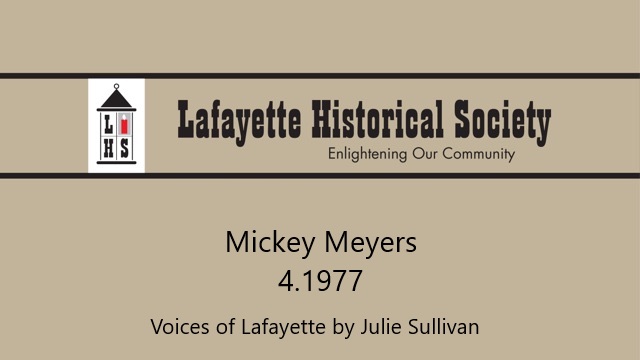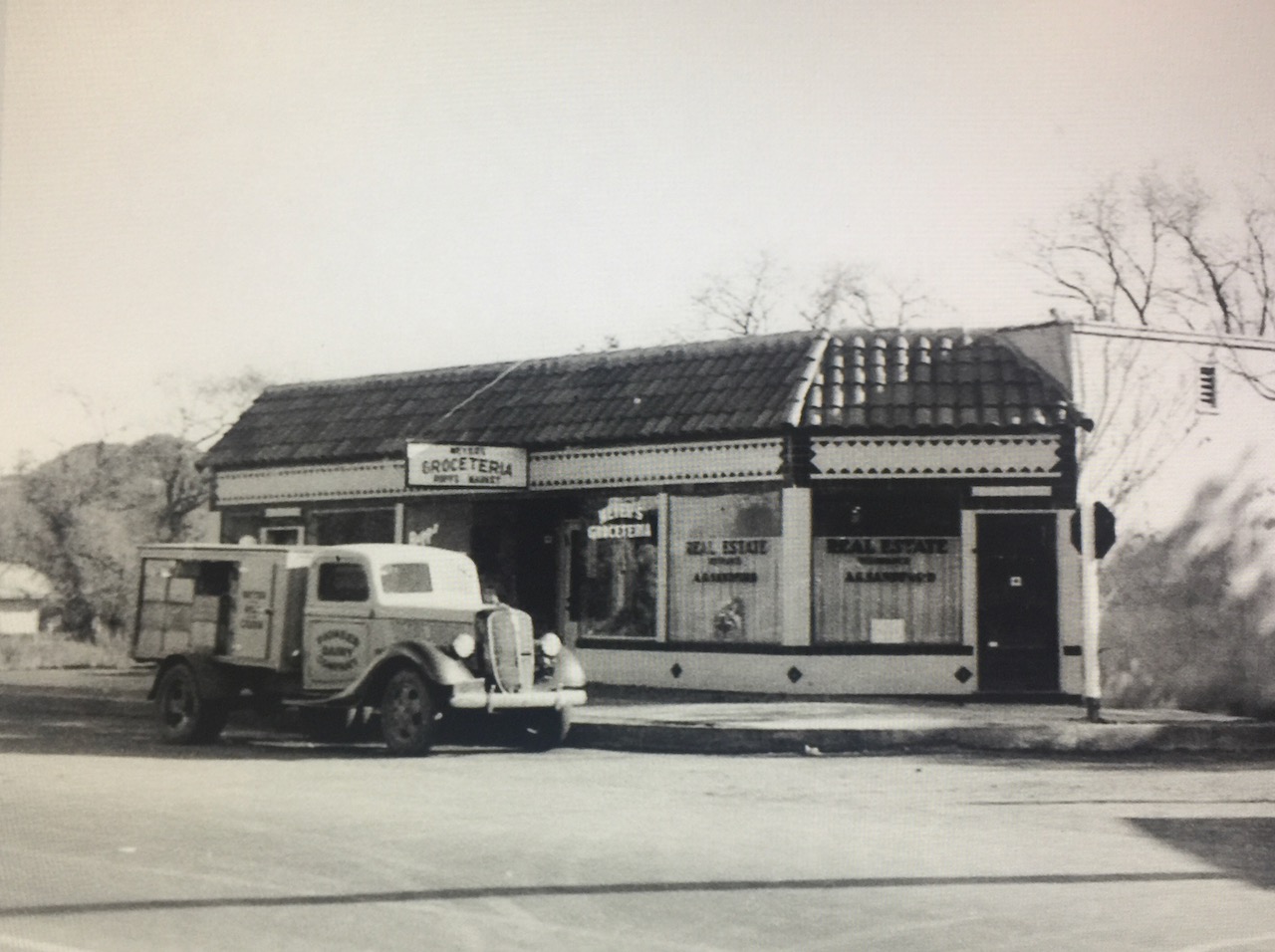Summary:
Mickey Meyers, who operated Meyers Groceteria on the site of the present-day Starbucks for many years, discussed his history in Lafayette in a speech in 1977. He came to town in 1936. He was originally recruited to help upgrade the main road through town in anticipation of the opening of the Bay Bridge and Caldecott Tunnel. Mickey discusses how the downtown area grew and changed in the decades in which he was a storekeeper.
Oral History:
“I came to Lafayette in 1936 from Visalia, California, where I was operating earth moving equipment, building roads and highways for the Union Paving Company. This was at the time the bridge and the tunnel were being completed, and they were upgrading all the roads going into the bridge.
The Union Paving Company got the contract for the stretch from Walnut Creek to Charles Hill, and I was the first carryall scraper on the job. My job was to run up and down the right-of-way scraping the grass and mixing it with the dirt so it would decompose before they started cutting the hills down and building a road.
We took a big slice out of that hill between here and Walnut Creek – or thought we did anyway – but boy, when they came along with this freeway they really took a slice out of it. At that time if you were going toward Walnut Creek you could only go as far as Moraga Road. You had to go down along Golden Gate Way because the road didn’t go straight ahead. There was a hill there with a little church on top, and they had to demolish that church before we could build a road.
I got a room with Luther Chandler who operated a grocery store on the corner of Hough Avenue and (at that time) Tunnel Road (Mount Diablo Boulevard). I ate my meals in Lou Borghesani’s bar and restaurant, and that’s the first time I met Lou. Chandler was Lou’s step father-in-law. That winter we had completed the road and were putting down the sub-grade, and because of rain, I couldn’t work for about three months. Luther Chandler said, ‘Why don’t you come and work in the store with me?’ When it came time to go back on the road again he said, ‘Mickey, construction work’s all right for a young guy, but you’re getting to the point you ought to settle down. Why don’t you buy the grocery store?’
He wanted $1,000 for the stock and fixtures. I barely had enough money to eat in those days. I wrote back East and borrowed $1,000 from my sister and went into the grocery business in 1937. Mr. Starks, Eleanor’s dad, had owned a meat market in back of the old hotel from 1915 to 1917. In 1915 he bought a lot on the corner of Hough Avenue and Tunnel Road and started building a store there. He completed it about 1917, then in 1920, he built living quarters on the back and moved the family there. He built the original store on this property.
In 1935, Clarence Brown had a store across the road, and he demolished that building and built a new store on that corner, which is exactly the same size as it is now. At that time, in the northeast corner Heinie Hodapp had a barber shop, and along the Hough Avenue side Captain Sanford had a real estate office. In 1935 Clarence Brown sold Luther Chandler the stock and fixtures and leased the building to him.
I ran that grocery store, and Bill Rupp ran the meat market until Eleanor graduated from high school, when I talked her into coming to work for me. The next September we got married. Eventually, we tore out the partition where the barber shop and real estate office were and had the whole store for a grocery store. At that time it was a very modern store. We put in all new fixtures and shelves and refrigerators. At that time frozen food was just coming in, so we put in frozen food cabinets. We were selling hamburger for 19¢ a pound, coffee for 39¢ a pound and bread at 10¢ a loaf.
Mr. Starks built the building in back of the store in 1945. Then I sold the store to Mort Sparling, who put a drug store there in 1949. In 1964, after Mr. & Mrs. Starks passed away, we covered the creek back there and put the parking lot in.
The highlight of the year when I arrived was the annual Horse Show and Fiesta de Lafayette. I got here in 1936, and I understand the horse show started in 1935. Lou tells me they had a Fiesta in 1934, but the show started in 1935. At that time there were about 300 horses from Contra Costa County and other East Bay cities. It was a two-day program, held in August at the Hamlin Ranch. It was kicked off by a parade starting at the horse show grounds, going up Brook Street, across Dewing and down Mt. Diablo, then back to the grounds. This parade was really something to see. They had every kind of wagon, buggy, stagecoach, floats, besides all the horses and beautiful silver saddles and bridles and costumes.
As I understand, the original purpose of the Fiesta was to raise money to improve the playground at Lafayette School. In 1943, the last year they held the horse show, Lou and I were out there bulldogging calves in the arena. Lou and I were on the membership committee of the Horseman’s Association, when they had an option on 43 acres between Jonas Hill Road and Burton Station. They were going to build a club house and stable and arena for a permanent place for the horse show. It’s a crying shame that never went through, because Lafayette would have been known the world over for the horse show. But it came up in the war years, around 1943, and just fell through.
In the 30’s and 40’s Lou’s was the place to go. At that time it was in the old red building that now sits in back of the Roundup, parallel to the creek facing Hough Avenue. At that time it faced Mt. Diablo right about where the parking lot is now.
Lou’s was the place to go in the evening. It was always crowded. It was a gathering place for everybody in Lafayette. There were slot machines.
For entertainment in those days there was usually a dance on Saturday night either at the I.D.E.S. Hall (we called it the Holy Ghost Hall) in Walnut Creek – it was a big wooden building with benches all around the room – and in the summer we went up to Valente’s Ranch on Acalanes Road. They had an open air pavilion. In those days the high school kids walked from Lafayette to Valente’s, and to Walnut Creek to the dances.
After Acalanes High School was built in 1940 or 1941 Irwin Mattson, who was a teacher and coach, said, ‘Lou, I would like to light that ballfield, and the district doesn’t have any money.’ Lou came up with the idea that he would sell bonds to Lions Club members and other businessmen and get enough to put up lights on the ballfield. Lou and I and a committee sold those bonds. We sold enough bonds to raise $16,000 to light the field. The bonds were paid off from gate receipts in four years.
In 1936, I don’t remember a concrete sidewalk in town. There were some wooden ones. Pioneer Market had one and Starks had some wood, and a porch-like thing over Browns, but no concrete. The road was just dirt, but when they built the new road there were curbs and gutters, and they started building sidewalks.
Starting from Stark’s store in 1936 and going east there was about 100 feet of vacant property. When Dad Starks said he was going to build a store there everyone asked, ‘Why are you going to build a store clear out of town?’ There was nothing until you came to the little schoolhouse, a building that housed the telephone exchange, post office and library.
Amelia Schott was postmistress, and Marie Mischaut was the telephone operator. Catherine Shutt was one of the operators. Carrie Van Meter still hauled the mail from the station, and I think she took care of the library, too. Then you came to Marie Bill’s place and Manuel Lucas’ service station on the corner. Later he put in the Associated Station.
That was all the buildings there were until you got down to the Pioneer Store. Going west from Lou’s place was Bert Mornini’s service station, and Ed Morrison had a combination plumbing shop and fire house, and I think a drug store beyond that.
I don’t know if Stanley had the drug store and Winkler worked for him, or if that came later. On the north side of the street there was the blacksmith’s shop. Eleanor’s uncle owned the blacksmith shop. Right next to that was a little shack, a hot dog and ice cream shack, then Carrie Van Meter’s house. They tore those houses down about 1936 and three buildings across the road next to Oak Hill Road – Clarence Brown’s hardware store and Heinie Hodapp’s barber shop, and I think Garrett had a shop there.
By the fall of 36 those buildings were all gone. They had to be demolished to widen Tunnel Road. By Christmas of 1936 there were no stores beyond Carrie Van Meter’s house.
I would swear that C. C. Morse started the first newspaper here in 1936, but Leo Coleman told me Al Snedeker started a newspaper before that. I thought Morse started the first paper, the Lafayette Sun. Morse had the paper for a couple of years then sold it to Wadsworth. Then Morse bought it back and then sold it to Carl Detar. Then it was eventually sold to Silverman. He built a place on Oak Hill Road and put in presses and printed the paper there.
During the 1940’s, the war years, St. Mary’s had pre-flight school, and there were a lot of servicemen in the area. Lafayette became famous or notorious as ‘The Strip’ because of all the nightclubs we had. After you passed Upper Happy Valley Road coming from Orinda, Knappenberger had the Red Mill, then you came into town, and right where the road curved was The Curve where Cape Cod is. Where Lafayette Federal is was Alsam, then Gus Schwartz’s Tunnel Inn, then on the corner of Oak Hill and Mount Diablo was the Rose Lee, later changed to El Molino and later again to Danny Van Allen’s.”
Excerpted from “Voices of Lafayette” by Julie Sullivan. This book is available for purchase in the History Room.



Leave a Reply